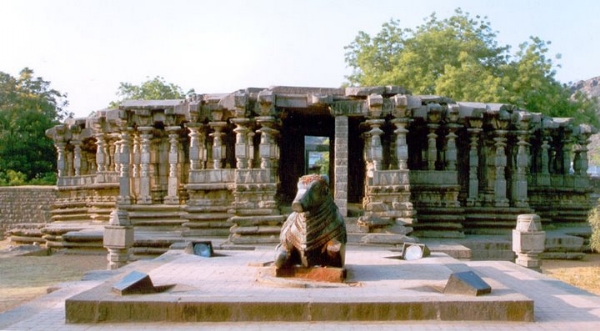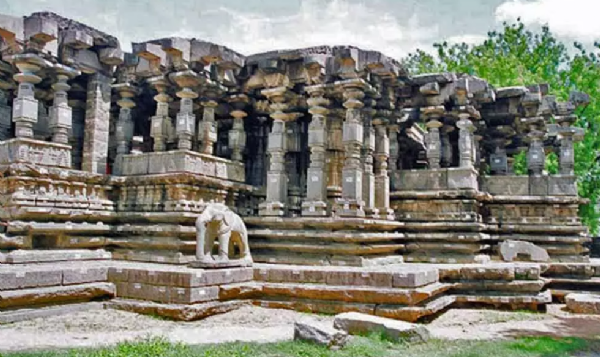Rudreshwara, the 1000 Pillar Temple of Warangal
17 Mar 2022 16:34:16
An excellent example of architectural excellence during the reign of Kakatiya rule, the 1000 Pillar Temple is a place not only devotees but also for history enthusiasts and architecture buffs! A definite must visit in Warangal, this 1000 Pillar Temple will leave you mesmerized with its beauty and intrigue you with its historical significance. The Temple, with its ruins, is near the Hanamkonda-Warangal Highway in Telangana, roughly 150 kms from Hyderabad.

The entire structure of the 1000 Pillar Temple is in the shape of a star. The intricately carved pillars support the structure of the temple while captivating sculptures add exquisiteness to the walls.

As you enter the temple, on the both side of the entrance beautifully carved sculpture of elephants greets you. Carvings on the ceilings of the temple and its exterior walls are also equally enticing.
Did you know | One of the interesting aspect of 1000 Pillar Temple is that here the third deity is not Lord Brahma who is considered to be one of the Trinity (Lord Shiva, Vishnu and Brahma). Instead, Lord Surya is being worshipped here as the third deity.
Also, though it’s called the 1000 pillar temple, the temple doesn’t really have those many pillars. The actual number is a little over 300. The name came from tourists who were amazed to see those many pillars, they started calling it the 1000 Pillar Temple. Somehow the name has stuck.

Built in 12th century, by the Rudra Deva, this temple is dedicated to Lord Shiva. Named as Sri Rudreshwara Swamy Temple, it has been built in architectural style of Chalukyan Temples. As the name says, this temple has many exquisitely carved pillars. Its rock cut elephant sculpture, a huge monolith of Nandi, intricate carvings will leave you mesmerized. The spiritual aura of the 1000 Pillar Temple will make your experience an enriching one. The temple is also locally known as Veyisthambala Gudi.
History | Built during the period of 1163 AD during the reign of King Rudradeva, the Temple is considered to be a masterpiece of the vishwakarma sthapathis of Kakatiya kingdom. The temple has been built in the architectural style similar to the Chalukyan temples and is one of the fine and earliest examples of Kakatiya art.
It is said to be named after the King Rudra Deva and hence is known as Sri Rudreshwara Swamy Temple. It was destroyed by the Tughlaq dynasty during their invasion of the Deccan. Only the Shiva shrine is worshipped in this temple as Vishnu & Surya shrines were devoid of idols which are missing.
Architecture | The 1000 Pillar Temple, built at the base of Hanamkonda hill, is dedicated to 3 deities. There are 3 separate shrines here - one for each presiding deity. Known as Trikutalayam, these main deities of the temple are Lord Shiva, Lord Vishnu and Lord Surya. The shrine of Lord Shiva is facing the east direction while the other two shrines are facing South & West. The shrines of Lord Vishnu and Lord Surya are connected to the main shrine of Lord Shiva via a square shaped mandapam.
Also Read | Vidyashankar, the Zodiac temple in Sringeri
On the 4th side of the temple is a carved monolith of Nandi. Carved out of one single rock, the sculpture of Nandi presents a glimpse into the artistic fineness of the earlier eras. The statue is facing east direction, which is rare, as most other statues of Nandi usually face the west.
The entire structure of the 1000 Pillar Temple is in the shape of a star. The intricately carved pillars support the structure of the temple while captivating sculptures add exquisiteness to the walls.

Foundations of the Temple have been done using the sandbox technique. The work of Kakatiya sculptors has manifested in the craftsmanship as well as the flawless carving techniques in their art. The imagination of the Kakatiya era sculptors is seen in the art of lathe-turned & polished dolerite / granite stone sculptures.
As you enter the temple, on the both side of the entrance beautifully carved sculpture of elephants greets you. Carvings on the ceilings of the temple and its exterior walls are also equally enticing.
Also Read | Mystery of the Underground Shiva Temple in Hampi
Now managed by the Archaeological Survey of India, this temple was renovated by Government of India in 2004. It has been declared as protected monument. What makes this temple even more attractive is its good maintenance. There is a lush green lawn that greets you as you enter the temple complex. There is also the facility of drinking water here at the temple.
Also, though it’s called the 1000 pillar temple, the temple doesn’t really have those many pillars. The actual number is a little over 300. The name came from tourists who were amazed to see those many pillars, they started calling it the 1000 Pillar Temple. Somehow the name has stuck.
